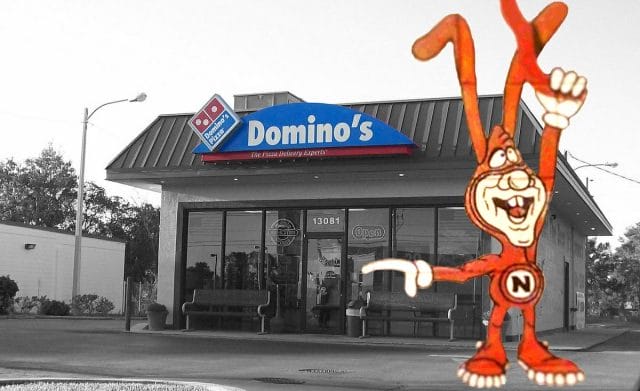
In 1960, Tom and James Monaghan borrowed $900 and bought a small, ailing pizza shop on the fringes of the Eastern Michigan University campus. Early on, business was horrible and James sold his half of the company to his brother for a used Volkswagen Beetle. Tom persisted and, by 1978, had expanded Domino’s Pizza into a 200-store enterprise worth $500 million.
During this period of rapid growth, Domino’s Pizza set an industry precedent that would prove critical to their success: they guaranteed that if a customer didn’t receive his pizza within 30 minutes of placing the order, it’d be free. Domino’s executives hired an external marketing firm, Group 243, to promote this new promise. The result? The “Noid.”
A troll-like creature, the Noid was outfitted in a skin-tight red onesie with rabbit-like ears and buck-teeth. Will Vinton, whose studio animated the creature, described it as a “physical manifestation of all the challenges inherent in getting a pizza delivered in 30 minutes or less.” Its name, a play on “annoyed,” was an indication of its nature: many considered the Noid to be one of the most obnoxious mascots of all time. Throughout the late 80s, Domino’s ran a series of commercials in which the Noid set about attempting to make life an utter hell for pizza consumers:
The spots soon employed the slogan “Avoid the Noid,” and reminded customers that their company’s pizzas were “Noid-proof.” The campaign was a smash success. In 1989, a computer game, “Avoid the Noid,” was released to commemorate the red antagonist (the goal was to deliver a pizza with a half-hour whilst avoiding a lumbering swarm of Noids), plush toys were abound, and the character was a household name.
Then, right at the height of his popularity, the Noid endured perhaps the worst mascot PR in history.
On January 30, 1989, a man wielding a .357 magnum revolver stormed into a Domino’s in Atlanta, Georgia and took two employees hostage. For five hours, he engaged in a standoff with police, all the while ordering his hostages to make him pizzas. Before the police could negotiate with his demands ($100,000, a getaway car, and a copy of The Widow’s Son — a novel about Freemasons), the two employees escaped. In the ensuing chaos, the captor fired two gunshots into the establishment’s ceiling, was forcefully apprehended, and received charges of kidnapping, aggravated assault, and theft by extortion.
The assailant, a 22-year-old named Kenneth Lamar Noid, was apparently upset about the chain’s new mascot. A police officer on the scene later revealed that Noid had “an ongoing feud in his mind with the owner of Domino’s Pizza about the Noid commercials,” and thought the advertisements had specifically made fun of him. A headline the following morning in the Boca Raton News sparked a talk show frenzy: “Domino’s Hostages Couldn’t Avoid the Noid This Time.”
A subsequent court hearing found Noid innocent by reason of insanity; a paranoid schizophrenic, he was found to have “acute psychological problems,” was turned over to the Department of Human Resources, and ended up in Georgia’s Mental Health Institute, where he spent three months. Years later, in 1995, unable to shake the idea that the Domino’s ad campaign had intentionally targeted him, Noid committed suicide in his Florida apartment.
Following the ordeal, Domino’s swiftly terminated the Noid campaign. For nearly twenty years, the annoying character lay in glorious respite, before briefly returning in 2011 (his 25th anniversary). This time though, he was merely part of a short-lived promotional marketing campaign: in Domino’s Facebook game, “The Noid’s Super Pizza Shootout.” As quickly as he came, the Noid returned to the void.
If you liked this blog post, our book is even more interesting → Everything Is Bullshit.
This post was written by Zachary Crockett. Follow him on Twitter here, or Google Plus here.




